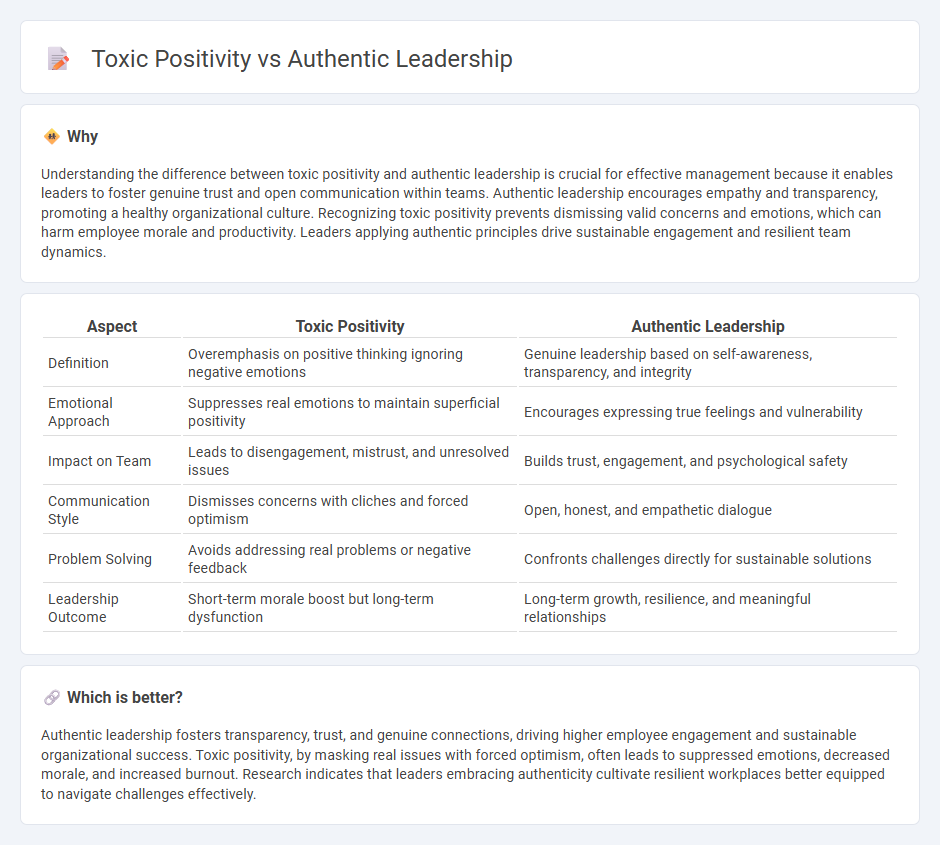
Toxic positivity in management undermines team trust by dismissing genuine emotions and challenges, fostering a superficial work environment. Authentic leadership promotes transparency and empathy, enabling leaders to address issues constructively while supporting employee well-being. Discover effective strategies to balance positivity with authenticity for a resilient organizational culture.
Why it is important
Understanding the difference between toxic positivity and authentic leadership is crucial for effective management because it enables leaders to foster genuine trust and open communication within teams. Authentic leadership encourages empathy and transparency, promoting a healthy organizational culture. Recognizing toxic positivity prevents dismissing valid concerns and emotions, which can harm employee morale and productivity. Leaders applying authentic principles drive sustainable engagement and resilient team dynamics.
Comparison Table
| Aspect | Toxic Positivity | Authentic Leadership |
|---|---|---|
| Definition | Overemphasis on positive thinking ignoring negative emotions | Genuine leadership based on self-awareness, transparency, and integrity |
| Emotional Approach | Suppresses real emotions to maintain superficial positivity | Encourages expressing true feelings and vulnerability |
| Impact on Team | Leads to disengagement, mistrust, and unresolved issues | Builds trust, engagement, and psychological safety |
| Communication Style | Dismisses concerns with cliches and forced optimism | Open, honest, and empathetic dialogue |
| Problem Solving | Avoids addressing real problems or negative feedback | Confronts challenges directly for sustainable solutions |
| Leadership Outcome | Short-term morale boost but long-term dysfunction | Long-term growth, resilience, and meaningful relationships |
Which is better?
Authentic leadership fosters transparency, trust, and genuine connections, driving higher employee engagement and sustainable organizational success. Toxic positivity, by masking real issues with forced optimism, often leads to suppressed emotions, decreased morale, and increased burnout. Research indicates that leaders embracing authenticity cultivate resilient workplaces better equipped to navigate challenges effectively.
Connection
Toxic positivity undermines authentic leadership by promoting superficial optimism and dismissing genuine employee emotions, leading to decreased trust and engagement. Authentic leaders foster open communication and acknowledge challenges, creating a psychologically safe environment that counters the harmful effects of toxic positivity. This connection highlights the importance of emotional honesty in effective management practices to enhance team resilience and performance.
Key Terms
Self-awareness
Authentic leadership centers on self-awareness by encouraging leaders to acknowledge their emotions and limitations, fostering genuine connections and trust within teams. In contrast, toxic positivity disregards authentic emotional experiences, promoting an unrealistic, overly optimistic mindset that can suppress vulnerability and hinder personal growth. Explore how embracing true self-awareness in leadership can transform workplace culture and enhance team resilience.
Emotional honesty
Authentic leadership emphasizes emotional honesty by encouraging genuine expression of feelings and fostering trust within teams, contrasting sharply with toxic positivity which dismisses negative emotions and promotes unrealistic optimism. This genuine approach leads to healthier workplace dynamics, increased resilience, and stronger connections among team members. Explore how embracing emotional honesty can transform leadership effectiveness and organizational culture.
Psychological safety
Authentic leadership fosters psychological safety by encouraging open communication, vulnerability, and genuine connections within teams, which supports trust and innovation. In contrast, toxic positivity undermines psychological safety by dismissing genuine emotions, promoting unrealistic optimism, and creating pressure to suppress concerns, leading to increased stress and disengagement. Discover how balancing authenticity and positivity can enhance psychological safety in your organization.
Source and External Links
What Is Authentic Leadership? - This webpage discusses Bill George's Authentic Leadership model, focusing on qualities such as a sense of purpose and passion that genuinely connect leaders with their employees.
Authentic Leadership: 5 Big Mistakes that Can Derail Your Influence - This article highlights common mistakes that can undermine authentic leadership, such as over-sharing confidential information or reacting impulsively, and emphasizes the importance of thoughtful action.
Authentic Leadership: What It Is & Why It's Important - This blog post explains how authentic leadership fosters trust, productivity, and positive work environments by promoting integrity, responsibility, and principle-based decision-making.
 dowidth.com
dowidth.com